Assessment
Dynamax Movement Assessments
The Overhead Squat Test
The Overhead Squat Test can be used as a general assessment to reveal any imbalances or limitations in ranges of motion prior to training with the Dynamax Medicine Ball.
- Have your athlete stand tall with feet hip width apart and a hands overhead
- Place a 14″ diameter Dynamax Medicine Ball just behind the heels of the athlete
- Instruct your athlete to slowly lower into a squat until their bottom touches the ball
- Repeat 6 times as you assess 2 squats from an anterior view, 2 squats laterally, and 2 squats from a posterior view
- Look for excessive inward or outward movement of the knees, arching or rounding of the back, and/or arms falling forward during the upward and downward phase of the squat
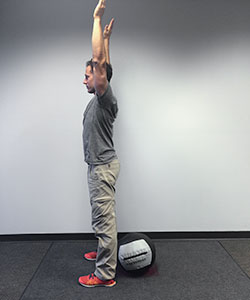
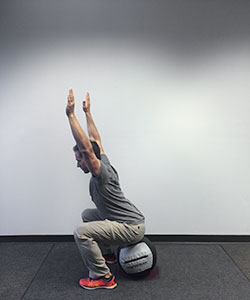
Cornerstone Assessments
The following Dynamax Cornerstone exercises are foundational to all other medicine ball progressions and can be used for assessment. Use a 4lb (2k) or 6lb (3k) Dynamax Medicine Ball when administering these assessments.
Instruct and assist your athlete in performing these three exercises to uncover imbalances and compensations related to the 10 General Physical Skills:
- Balance
- Accuracy
- Agility
- Coordination
- Power
- Speed
- Flexibility
- Strength
- Stamina
- Cardiovascular Endurance
Consistent practice of the following exercises post-assessment will correct movement / physical skill deficiencies, clearing the athlete to perform all progressions.
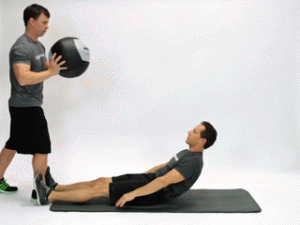
Cornerstone Assessment #1
This assessment measures stamina, accuracy, power, and coordination during ground-based exercises.
Have your athlete perform 10 repetitions of the Sit-Up Throw to determine if he or she can accurately and consistently place that ball at your chest, sequentially accelerating form the top down in one coordinated throwing pattern. This will also measure your athlete’s ability to summate force from a lying position.
Sit Up Throw
- The athlete begins seated on the floor, legs extended, with the coach positioned at the feet of the athlete in a split stance.
- The coach initiates the movement by tossing the ball just above the head of the athlete.
- The athlete’s trunk loads eccentrically while lowering completely to the ground with the ball overhead.
- The athlete taps the ball on the ground before sitting up while throwing the ball with velocity aiming for the coach’s chest.
- The sit-up is initiated with a throwing action of the arms followed by flexion of the trunk.
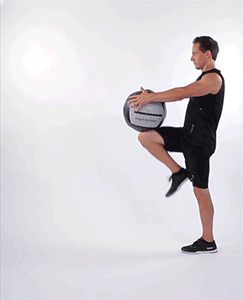
Cornerstone Assessment #2
This assessment measures coordination, balance, flexibility, dynamic postural stability, and speed during locomotion.
Have your athlete perform the High Knee March for 25 yards, or for 30 seconds. The athlete should maintain an upright posture throughout the exercise. The knee should lift to 90 degrees when striking the ball. The foot should touch town in the mid sole to forefoot between each alternating knee strike.
High Knee March
- The athlete begins seated on the floor, legs extended, with the coach positioned at the feet of the athlete in a split stance.
- The coach initiates the movement by tossing the ball just above the head of the athlete.
- The athlete’s trunk loads eccentrically while lowering completely to the ground with the ball overhead.
- The athlete taps the ball on the ground before sitting up while throwing the ball with velocity aiming for the coach’s chest.
- The sit-up is initiated with a throwing action of the arms followed by flexion of the trunk.
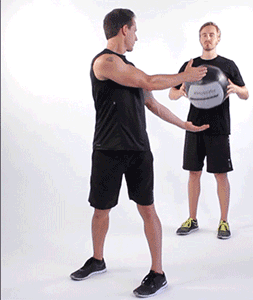
Cornerstone Assessment #3
The basic “washing machine” rotation measures balance, agility, flexibility, and rotational power. The athlete should perform 10 repetitions (5 each side), while maintaining a tall, upright posture. The ball should remain on a horizontal plane while accelerating, picking up momentum until it’s released on the opposite side. Sufficient thoracic mobility will allow the athlete to perform the rotation without compensation in the ankles or knees.
Basic Rotation
- The athlete begins seated on the floor, legs extended, with the coach positioned at the feet of the athlete in a split stance.
- The coach initiates the movement by tossing the ball just above the head of the athlete.
- The athlete’s trunk loads eccentrically while lowering completely to the ground with the ball overhead.
- The athlete taps the ball on the ground before sitting up while throwing the ball with velocity aiming for the coach’s chest.
- The sit-up is initiated with a throwing action of the arms followed by flexion of the trunk.
Our Address
4600 SH-123
San Marcos
Texas
78666
Have you check our FAQs for an answer? If they didn't help, please contact us and let us know what you need!